 |
New York
Architecture Images-Upper West Side Hotel/ Cafe des Artistes |
|
architect |
George Mort Pollard (Walter Russell was said to be involved) |
|
location |
One W67, bet. Central Park West and Columbus Ave. |
|
date |
1918 |
|
style |
Gothic |
|
construction |
|
|
type |
Hotel |
|
|
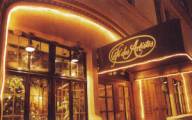 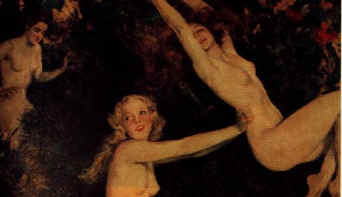 |
|
images |
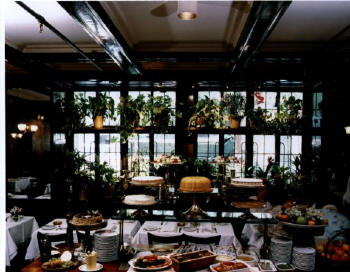  |
|
|
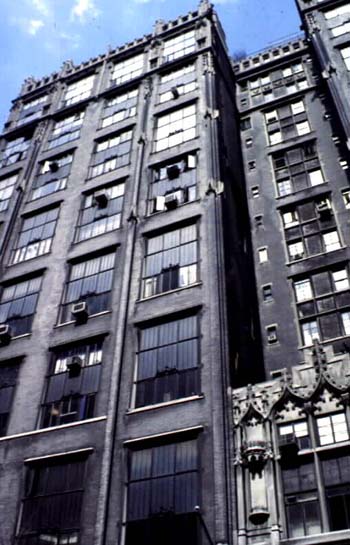 |
|
ROBERT'S CUBE About two decades ago, this
duplex unit at the famed Hotel des Artistes was home to Irving Howe, the
late firebrand social and literary critic. In fact, Howe-who rented at
the building while between marriages-was actually just one of a gaggle
of prominent artists who have lived in the building since its erection
in 1915 as an artists' studio. The tenant roster has included painter
Norman Rockwell, director Mike Nichols, actor Gary Oldman, playwright
Noel Coward, writer Fannie Hurst and dancer Isadora Duncan. The latest
owner of Howe's old apartment is himself an artist of sorts: prominent
New York architect Robert Marino. "The apartment is kind of like a
Rubik's Cube," said Mr. Marino. "That's what appeals to me
architecturally about it. It's compactly put-together and very
efficient." Mr. Marino, whose contemporary-styled residential and
commercial projects dot the landscapes of Westchester, Manhattan and the
Hamptons, happened upon the apartment after his wife saw an ad in the
Sunday New York Times. "It said something like: 'Needs great vision,'"
Mr. Marino remembers his wife saying. Great vision, indeed. The
apartment hadn't been renovated since at least the 1950's. It had
belonged to a retired college professor of medieval history-who had
sublet the apartment to Howe. "It needs a tremendous amount of work,"
said listing broker Andrea Davis, who shared the listing with fellow
Coldwell Banker Hunt Kennedy broker Scott Claster. That, according to
Mr. Marino, explains how he snagged the space for such a price. And as
befits his occupation, he's planning to refurbish just about every
square foot of it, from the walls to the floors to the windows. Mr.
Marino, who'd been living with his family in a smallish two-bedroom
apartment in Chelsea, said that the apartment's set-up and location is
perfect for his 2-year-old twins, Luke and Jake. "It's kind of like a
compact playhouse," Mr. Marino said. "And the park is right next-door.
An 800-acre front yard-you can't beat that."
Phone: +1 212 877 3500 Think Café des Artistes and it’s Christmas
in New York. No other dining room in the city captures the sparkle of
the season like this jewel-box of a restaurant in the Hotel des Artistes
where George Balanchine used to live and where a few blocks away at
Lincoln Center his Nutcracker Suite enchants an ever new generation each
holiday season. Howard Chandler ChristyHoward Chandler Christy was one of America's most distinguished illustrators, whose work, like that of Norman Rockwell, successfully captured the pulse of the nation.His career was established when he worked for "Scribner's" and "Leslie's Weekly" doing illustrations of American troops in Cuba during the Spanish American War. After that, he was most sought after for his sumptuous, lush portraits of women, although he also painted other notables that included President Calvin Coolidge, General Douglas McArthur, Eddie Rickenbacker, Douglas MacArthur, Amelia Earhart, Herbert Hoover, and Benito Mussolini. He was also a muralist and much sought-after teacher, giving classes in New York City at Cooper Union, the Chase School, the New York School of Art, and the Art Students League. Christy was born in Duncan Falls, Ohio where he grew up on his family farm. At age sixteen, he went to New York City to study at the Art Student's League, and after less than four years, he entered the National Academy of Design where he won two prizes in draughtsmanship. He worked for "Scribner's Magazine" as an illustrator for a number of years beginning in 1898. In addition to illustrating articles and stories, he traveled to Cuba and Puerto Rico and sent back illustrations of Spanish-American War activity. It was through this work as a commercial artist that he became a nationally known illustrator. After his return to the United States, he taught for a brief time in New York; however, he soon returned to his hometown of Duncan Falls. There he built a studio and summer home and divided his time between painting and entertaining visiting authors and publishers. While living in Ohio, he became famous for his stylized depictions of women, popularly known as "Christy Girls." These illustrations appeared in many publications and print art, and were eventually used on recruitment posters for Word War I. By 1915, he had returned once again to New York City and soon took up portrait painting. Later in life Christy began painting large historical murals. In 1945, he was commissioned by the state of Ohio to paint "The Signing of the Treaty of Greene Ville," which today hangs in the Ohio Statehouse in Columbus. His most famous of these large compositions, "The Signing of the Constitution of the United States" is located above the grand staircase in The Capitol in Washington DC. Christy died in 1952 in his studio apartment at the Hotel des Artistes |
|
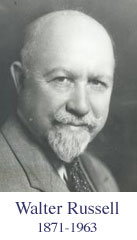 Walter Russell dropped out of school in grade 8 in order to help support his family. Always sensing a deep inner connection, he became aware of his genius no matter to what endeavor he turned his hand, becoming a world class pianist, artist, sculptor, writer, architect and figure skater. As his awareness of the true nature of man grew, he knew that anyone could do likewise. In 1921, Russell experienced a 39-day cosmic illumination. From what he learned in that experience, coupled with studies in traditional science, he formulated the "Russell Cosmogony," through his books The Universal One, The Russell Genero-Radiative Concept, The Secret of Light, and A New Concept of the Universe. Though skoffed at by the scientific community of his time, he was later to be recognized for identifying new elements in the Periodic Table and work that is now being echoed in quantum physics. Walter Russell was
one of the greatest geniuses ever to walk the planet. Even though
Russell died in the 60's, he greatly changed the world we live in today.
Walter Russell felt it was his Life Purpose to be an example to mankind
that we all have genius inherent within us.
LIGHT
Chapter XII,
The Secret of Light
When man sees the light of the sun he believes that he is actually
seeing light when the nerves of his eyes are but “feeling” the intense,
rapid, short- wave vibrations of the kind of wave motion which he senses
as incandescence. The intensely vibrant electric current mirrored into
the senses of the eyes fairly burns them. They cannot stand that high
rate of vibration. The eyes would be destroyed by such a vibration but
light would not be the cause of that destruction. Fast motion,
simulating light, would be the cause. It would be like sending a high
voltage electric current over a wire, so fine that the current would
burn it out.
Man likewise cannot see darkness. The nerves of his eyes, which sense
motion, slow down to a rate of vibration that he can no longer “feel.”
Man is so accustomed to the idea that he actually sees light in various
intensities illuminating various substances to greater or lesser degree
that it is difficult for him to realize that his own senses are but
acting as mirrors to reflect various intensities of wave motion. But
that is all that is happening.
Every electrically conditioned thing in Nature reflects the vibrations
of every other thing, to fulfill its desire to synchronize its
vibrations with every other thing. All matter is the motion of light.
All motion is expressed in waves. All light waves are mirrors that
reflect each other’s condition unto the farthermost star.
This is an electrically conditioned wave universe. All wave conditions
are forever seeking oneness. For this reason all sensation responds to
all other sensation. Is Light A Wave Or Corpuscle?
Much controversy has arisen as to whether light is corpuscular, as
Newton claimed it to be, or waves. There is much evidence in favor of
both theories. It is both. Light is expressed by motion. All motion is
wave motion. All waves are expressed by fields of equal and opposite
pressures of two-way motion. The entire volume within wave fields is
filled with the two opposite expressions of motion—the positive
expression that compresses light into solids, and the negative
expression that expands it into space surrounding solids.
All space within wave fields is curved. Curvature ends at planes of zero
curvature that bound all wave fields. These boundary planes of
omnipresent magnetic Light act as mirrors to reflect all curvature into
all other wave fields in the universe, and as fulcrums from which motion
in one wave field is universally repeated. All Matter Is Wave Motion
Together these constitute what we call matter and space. It has been
difficult to conceive light as being purely corpuscular, for light is
presumed to fill all space. Space is not empty. It is full of wave
motion. Corpuscles of matter are one half of wave cycles of light. Space
is the other half.
There need be no mystery as to whether light is corpuscular or wave, for
waves of motion which simulate the light and darkness of space is all
there is.
The light and motion of solid matter, and of gaseous matter of space,
differs only in volume and condition. Water of earth is compressed into
small volume while water of the heavens is expanded thou sands of time
in volume. Each condition is the opposite half of the cycle of water.
Water vapor is water turned inside out. It again becomes water by
turning outside in. Expansion- contraction sequences result from this
process. All Matter Is Simulated Light
Water of the heavens still is water, and it still is light waves. No
change whatsoever has taken place between the waters of earth and those
of the heavens except a change of its condition from positive to
negative preponderance. This change is due solely to a change of its
direction in respect to its center of gravity.
All dense cold matter, such as iron, stone, wood, and all growing or
decaying things, are light. We do not think of them as light but all are
waves of motion, and all waves of motion are light.
Light is all there is in the spiritual universe of knowing, and
simulation
of that light in opposite extensions is all there is in the electric
wave universe of sensing. The simulation of light in matter is not
light. There is no light in matter.
Perhaps the confusion which attends this idea would be lessened if we
classify everything concerning the spiritual universe, such as life,
intelligence, truth, power, knowledge and balance as being the One
Light of Knowing, and everything concerning matter and motion as
being the two simulated lights of thinking.
Thinking expresses knowing in matter but matter does not think, nor does
it know.
Thinking also expresses life, truth, idea, power and balance by
recording the ideas of those qualities in the two lights of matter in
motion, but matter does not live, nor is it truth, balance or idea, even
though it simulates
those spiritual qualities.
Man’s confusion concerning this differentiation lies in his, long
assumption of the reality of matter. His assumption that his body is his
Self, that his knowledge is in his brain, and that he lives and dies
because his body integrates and disintegrates, has been so fundamental a
part of his thinking that it is difficult for him to reverse his
thinking to the fact that matter is but motion and has no reality beyond
simulating reality.
The light which we think we see is but motion. We do not see
light. We feel the wave vibrations set up by the motion that
simulates light, but the motion of electric waves that simulate light is
not that which it simulates. ConfusionConcerning Light Corpuscles
There is much confusion concerning the many kinds of particles of matter
such as electrons, protons, photons, neutrons and others. These many
particles are supposedly different because of the belief that some are
negatively charged, some are positively charged and some are so equally
charged that one supposedly neutralizes the other.
There is no such condition in nature as negative charge, nor are there
negatively charged particles. Charge and discharge are opposite
conditions, as filling and emptying, or compressing and expanding are
opposite conditions.
Compressing bodies are charging into higher potential conditions.
Conversely, expanding bodies are discharging into lower potential
conditions. To describe an electron as a negatively charged body is
equivalent to saying that it is an expanding-contracting body.
Contracting and expanding bodies move in opposite directions.
Contracting bodies move radially inward toward mass centers, and
expanding bodies move radially outward toward space that surrounds
masses. In this two-way universe, light which is inwardly directed
toward gravity charges mass and discharges space. When directed toward
space it charges space and discharges mass. All direction of force in
Nature is spiral.
The charging condition is positive. It multiplies speed of motion into
density of substance. The principle of multiplication of motion because
of decrease of volume is the cause of the acceleration of gravity. The
discharging condition is negative. It divides speed of motion into
tenuity of substance. The principle of the division of motion because of
expansion of volume is the cause of the deceleration of radiation.
One can better comprehend this principle by knowing that what we call
substance is purely motion. Motion simulates substance by its variation
of pressures, its speed and its gyroscopic relation to its wave axis.
Particles are variously conditioned as to pressure but there are no
different kinds of particles. All are light waves wound up into
particles that are doubly charged. Their position at any one point in
their wave causes them to have the electric condition appropriate for
that point.
Light particles are forever moving in their octave waves. All are either
heading toward their cathode or their anode, which means toward vacuity
or gravity. They are all moving either inward or outward, spirally. All Light Particles Are Alike
All light particles are either expressing the mother- light principle or
the father-light principle. For example, if a particle is on the
amplitude of the wave, it would be a true sphere, and as a true sphere
it would be neither positive nor negative. It might then appropriately
be called a neutron. A particle which is spirally heading inward toward
the apex of a vortex in the process of becoming a sphere might
appropriately be called a proton, because of its expressing the
father-light principle.
Again, if it is moving spirally outward, it could appropriately be
called an electron because it would then be discharging in excess of its
charge or expanding in excess of its contraction.
Light rays, for example, leaving the sun, are discharging the sun. They
are also discharging themselves because they are expanding into greater
volume. They are also lowering their own potential by multiplying their
volume. They reverse their charge when radially converging upon the
earth. They are then charging the earth and themselves by contracting
into smaller volume and are simultaneously multiplying their own
potential by thus contracting. Semi-cyclic Alteration
In an electric current there is a constant interchange between anode and
cathode or positive and negative poles. A light particle expands as it
leaves the cathode in an outward radial direction and contracts as it
radially approaches the anode. This light particle has been the same
light particle at all times in all parts of its journey. Its variation
of charge and discharge, its direction of motion and the condition of
wave pressure in which it finds itself at all times are the sole reasons
for its changing from one condition to another. The light particles are
all the same light particles, all being different only in pressure
condition.
This is also true of the elements of matter. Whether they be iron,
carbon, silicon, bismuth or radium, all are composed of the same kind of
light particles.
They all seem to have different qualities and attributes, but those
qualities and attributes are likewise given to them purely by the
positions they occupy in their waves. All Things Simulate Light
A particle of light which belongs to an atomic system of sodium has in
it all of the entire range of the elements, besides all of every other
creating thing in the universe. It acts to carry out the purposefulness
of the idea of sodium simply because it is in the pressure condition of
sodium, and is a part of the unfolding pattern of the seed of inert gas
of the octave from which it has unfolded.
If that same particle unfolded from the seed of the oak, it would be
part of the wood fiber of its trunk, or leaf, or of the chlorophyll
which colored its leaves, but it would be the same kind of particle
while fulfilling the purpose of cellulose as while fulfilling the
purpose of sodium.
All matter in this universe is but differently conditioned motion
simulating light, and all differences in condition are pressure
differences. Light Does Not Travel
The speed with which light presumably travels is 186,400 miles per
second. The distance between stars is so great that the speed of light
is computed as light years, for the distance computed by lesser units of
time would yield figures so great that they would be meaningless.
Light only seems to travel. It is but one more of the countless
illusions caused by wave motion. Waves of the ocean seem to traverse the
ocean but they only appear to do so, for waves are pistons in the
universal engines, and pistons operate up and down. Wave pistons of
light, or of the ocean, operate radially and spirally inward and
outward, toward and away from gravity.
Waves of light do not travel. They reproduce each other from wave field
to wave field of space. The planes of zero curvature, which bound all
wave fields, act as mirrors to reflect light from one field into
another. This sets up an appearance of light as traveling, which is pure
illusion.
The sunlight we feel upon our bodies is not actual light from the sun.
What actually is happening is that the sun is reproducing its own
condition on the earth by extending the reproductions out through cold
space into ever enlarging wave fields until those reproductions begin to
converge again toward our center of gravity into ever smaller wave
fields. The heat we feel and the light we see is dependent entirely upon
the ability of the wave fields to reproduce the light and heat, and that
ability is conditioned upon the amount of moisture in the atmosphere.
If there were no moisture in the atmosphere, our bodies would carbonize
from the heat thus reproduced. One cannot consistently think of that
heat as direct rays of the sun, for that same sunlight was intensely
cold during its reproduced journey through the immensely expanded wave
fields of space between the sun and earth.
The light and heat that appear to come from the star or sun have never
left the star or sun.
That which man sees as light and feels as heat is the reproduced
counterpart of the light and heat that is its cause.
The rate of vibration in a wave field depends upon its volume. Vibration
in a wave field means the pulse of interchange between its compressed
core and the space surrounding that core. A slow vibration in a large
wave field would cool one’s body, or even freeze it, while fast pulsing
interchange in extremely small wave fields could burn one’s body.
A lens that multiplies light and heat toward a focal point which sets
paper on fire merely compresses larger wave fields into smaller ones.
The rate of vibration increases for the same reason that the planets
nearest the sun move much faster in their small orbits than those that
are far away from the sun. Kepler’s law covering the speeds of planets
will apply to rates of vibration in wave fields as appropriately as with
the movements in the solar system. |
|
|
links |
http://www.philosophy.org/articles |